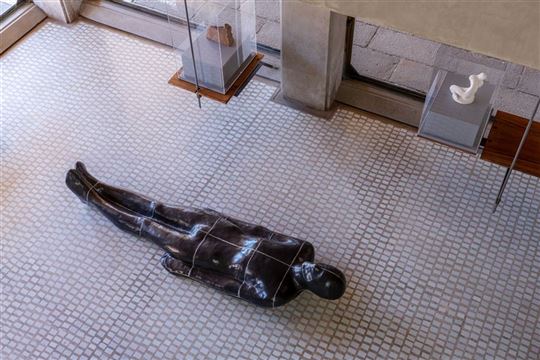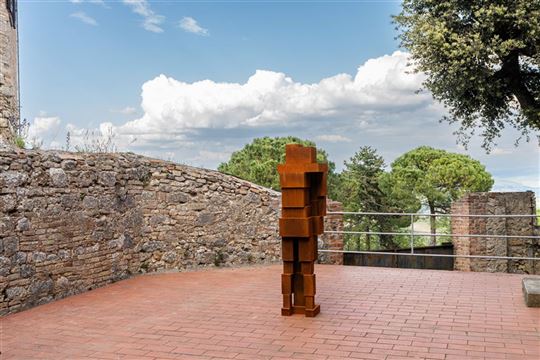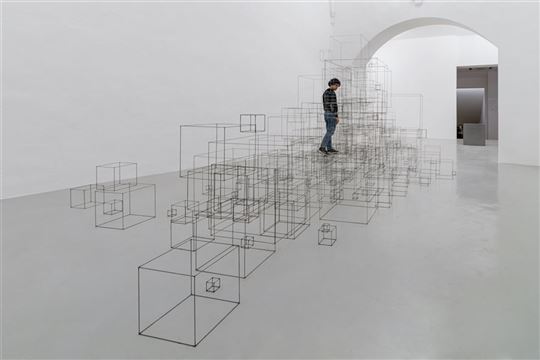
Antony Gormley: Body and consciousness
Like Lucio Fontana, he seeks the representation of the absolute. Throughout his 40-year career, he has tried to depict the space of interiority. A conversation with the most important living British sculptor. From the October issue of Tracce.He somewhat resembles T.S. Eliot, a little Roald Dahl, a little Roger Moore. It might be the shape of his nose, or his high forehead. Maybe his haircut. He is cultured, polite, elegant. Antony Gormley, the most important living British sculptor, has Britishness plastered across his face. Born in 1950, he studied Archaeology, Anthropology and Art History at Cambridge before going to art school in London. He took a two-year trip to India in the mid-1970s. His work, for which he was awarded the prestigious Turner Prize in 1994 and that has been exhibited in major museums around the world, is a reflection on the form of the human body and its relationship to space. His perhaps most iconic work is the Angel of the North (1998), created for the town of Gateshead in northern England along the A1 motorway. It is a human-shaped steel colossus, twenty meters high, which has two wings instead of arms, fifty-four meters wide. It is an enigmatic presence amid the landscape, just like many of the other sculptures that Gormley has often placed in evocative views by the sea or above city buildings (in 2019 one of them was placed atop the Loggia dei Lanzi in Florence).
We met with him before the summer and he told us that on Easter Day, April 17, he had been in Venice to set up the "Lucio Fontana / Antony Gormley" exhibition at the Negozio Olivetti in St. Mark's Square. Although he is no longer a believer, he wanted to participate in the solemn celebrations in St. Mark's Basilica and was struck by a mosaic: "On the left, looking at the altar, there is the scene of the incredulity of St. Thomas, in which the apostle makes to touch the wound in Christ's side. I noticed that while the other wounds on his feet and hands were drawn as a circle, the one that Thomas' finger approached was square. And I thought of Kazimir Malevič's Black Square."
This idea came to him from his confrontation with the theme of the absolute, an undercurrent throughout his work, which he has explored more deeply in recent years through the comparison of his work with that of Lucio Fontana. We suggested to him: the same happens in Caravaggio's painting of the same Gospel episode, in which Christ's wound seems to anticipate Fontana's cuts. Gormley confirmed this and put forward: "It is so also in the Guercino in the Vatican Museums, but even more so in Verrocchio's sculpture at Orsamichele. They all pre-empt him."
For the exhibition in Venice, he had access to more than 4,000 drawings by the Italian artist. Among them, he was struck by his notes for the "Technical Manifesto of Spatialism," which Fontana presented in 1951, proposing an alternative to the way in which, until then, Western art had approached the problem of verisimilitude. It was no longer a matter of following geometric perspective, based on the point of view of a man resting his feet on the ground. The artist was asking to take a leap, which was conceptual, and look at the world from space. It was a cosmic view, almost two decades before the photos of our planet taken by astronauts orbiting the moon. "Fontana takes a canvas, which is the traditional site of representation, and carves a cut into it. He denies, in a sense, the idea of mimesis and paves the way for the representation of the infinite." For Gormley, this approach is opposite and complementary to his own: "My way of recognizing the cosmic truth of an ever-expanding universe is to step out of the zone of perceptual appearance. Just close your eyes and you find yourself in darkness, in a space that has no objects, dimensions or age. It is the place of consciousness, which everything in contemporary society tries to make us evade.”
All of Gormley's work since the early 1980s is an attempt to depict this space of consciousness. Among his first endeavours at this is Rise (1983-1984), a sculpture representing the space occupied by the artist's body: a cast made on himself and enclosed by a lead envelope, across which orthogonal lines have been drawn like on a globe. The figure is placed on its back with its shoulder raised slightly off the floor. "What I wanted to show is the darkness inside me." Another work that is very similar to Rise is Untitled (for Francis), created in 1985, which is now kept at the Tate Modern in London. In this case, the human figure is standing, with its legs slightly apart and with outstretched arms, showing the palm of its hand. Holes can be seen on its feet, hands, and ribcage. "That work was born out of the failure of Rise," the artist explained, "People did not understand what I wanted to communicate and said it was a boring mummy. The idea for the new work came to me from seeing Giovanni Bellini's Saint Francis in the Desert at the Frick Collection in New York. My father was a fan of the Canticle of the Creatures and the Little Flowers ... So I took the saint’s position and drilled holes that are shaped like eyes. It is not a Christian image, but it is a gesture of openness to the world and space." In 2012, however, he made the monumental work Model: a building in the shape of a human body, 37 meters long and made of 22 metal parallelepipeds. Visitors can enter and move inside the sculpture, having the experience of being in the same infinite space contained within Rise or Untitled (for Francis).
Another way of developing the same theme, which is perhaps what Gormley is best known for, is achieved by the use of orthogonal lines. Rather than marking the surface of an enclosure, these take on a texture of their own and go to occupy the volume of the interior space. They are not skeletons, but architectural structures that represent the intimate place of consciousness. In a paradoxical game, the artist uses Cartesian axes to represent a dimension in which Cartesian logic loses its meaning. One of the most iconic examples from this series can be seen on the upper floor of the Venice exhibition: Subject III (2021), a man kneeling against the wall. "The idea on which my work is based," Gormley explains, "is that consciousness inhabits the body and the body inhabits architecture, and I use the syntax of the latter to describe our organism as a space of transformation. Our body is the arena of experience and consciousness. Mine is an invitation to take the time to rediscover this dimension. I am not interested in the viewer just being a spectator, but in them participating in the work. That is why, whenever possible, I make works in which one can enter and interact."
Such is the case with Frame II (2021), the large-scale work that was the highlight of the "Body Space Time” exhibition that just closed at the Continua Gallery in San Gimignano; this occupied the former stalls of the small cinema, home of the exhibition space. It is a structure composed of interpenetrating aluminium frames. Gormley intended for the interweaving of the lines to evoke the third position of the Islamic prayer sequence, in which the praying person rests on their knees, with their forearms and head on the ground. "It is a position that we might associate with that of the kneeling supplicant in Christian worship. It makes explicit that man depends on Allah's will and that also speaks of his connection with the earth. And it is also the posture in which the body occupies the least possible space. The work is open, and although it is the size of a house, it cannot be a shelter. It is placed where the stalls used to be, where the audience sat in silence, waiting for the performance to begin. It was the place of waiting and attention."
More recent works include Hold (Pieta) (2019), which seems to allude to an embrace, despite the fact that Gormley's sculptures usually only depict one body at a time. "Yes, it is about an embrace. But it has nothing to do with a romantic concept." The artist took out his smartphone and showed us a photograph of him naked while clinging to one of his life-size human body works, made of cast-iron and steel parallelepipeds. "It is a reflection on the relationship between the sculptor and the sculpture. I think it has to do with Michelangelo's obsession with the image of the Pietà, the Christian symbol where the mother of God holds up the dead body that she generated. I think it is a metaphor for the relationship between the sculptor and the inertia of matter. Between energy and stasis. I have the wish to create an equivalent of the human experience that, in a sense, can only contemplate death as well." He made it at the height of the pandemic, when contact between people was prohibited. "If it was just an attempt to illustrate a need related to the Covid period, it would be a complete failure," the artist explains, "I wanted it to be a meditation on the experience of sculpture, in which a living body attempts to imprint upon a piece of inert matter the possibility of empathy and feeling."
We asked him why, in talking about his works, he often makes references to concepts or realities related to religions. "Looking at the lexicon of body positions gives us access, in a sense, to the various kinds of cosmology, the worldviews that the desert religions have, rather than Buddhism or Taoism. And all these examples of positions are manifestations of a state of contemplation, which is the attitude we need to make art. They are positions that we associate with the idea of prayer, meditation or supplication. I am not saying that we should go back to the theistic worldview, but that the space of art shares with some religious practices and traditions the idea that we are in the world but we are not of the world." Is art therefore the last possible religion in a secularized world? "No, this is a simplification that distorts what I am trying to say. In the late capitalist age in which we find ourselves, in which values have collapsed into monetary value alone, art is important because it is a space for contemplation and reflection that, as such, should be protected."